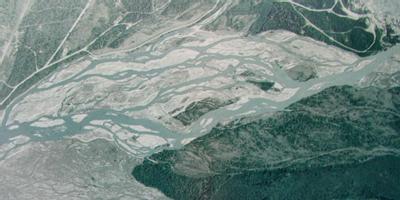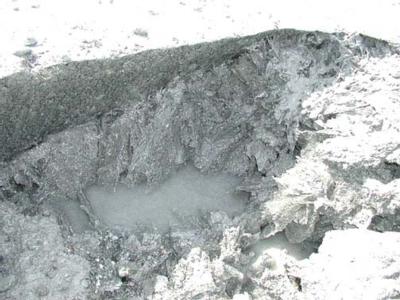26 July, 2000
July 26, 2000
Matanuska Glacier, Alaska
The great weather continued today but most of our time was spent indoors
looking at the samples from a few days earlier. We started off looking
at the samples taken at Mega Vent. This was the vent that we had not
sampled in our first dye test. Even before we had finished the samples
from this vent we knew that it was also connected to the moulin. There
was a rapid rise followed by a nice slow decline to zero concentration
just as we’d expected . Our idea to sample every five minutes paid off
in a more well defined curve of the concentrations. We also feel
confident that all the dye is flushed out and no more remains in the
glacier, so our window of collection times looks good. We saw no trace
of dye in this vent for the last ninety minutes. Everything seemed to
pass through in roughly one hundred minutes, after taking about 35 to
appear at the vent after being dumped. It is extremely similar to the
outcome at M-1 a few days earlier.
At this point we were pretty happy with things and feeling good about
the connectivity of our moulin with the Mammoth Vent area. Then came a
huge shock. We never saw a trace of dye come out of M-4 as we ran the
analysis.This was the vent that had given a double peak in our first
test and even had the highest concentration of dye coming out. The
connection must have shut itself off somehow. Although it took us by
surprise I guess it really shouldn’t have been totally unanticipated.
After all the biggest impression this glacier has left on me is how
dynamic it is and the drainage system beneath should be no different.
Now we are rethinking our strategy but we have not settled into anything
definite yet.
Perhaps we will try to use more ISCOs again and sample all the major
vents in the Mammoth area. We may also need to think about the flow rate
into the moulin because possibly at lower levels the water in the
glacier may not be high enough to “spill over” into a side channel.
We’re leaning toward looking at differences between morning and evening
results. If a low flow level is causing a channel to cut off then maybe
this test will demonstrate that. It could explain the absence of dye in
M-4. Perhaps the conduits are refreezing and closing down, only to
reopen a new pathway. We find ourselves developing a variety of
hypotheses. That is not too hard to do and is quite fun. The real
challenge is figuring out an experimental method to test them. That is a
difficult task with such a dynamic system. Cause and effect can be
methodically established through controlled experimentation. We’re
finding that there’s not a lot that we can control. It would be great if
we could keep sunlight and temperatures constant and control the volume
of water into the moulin, maintaining a constant flow rate 24 hours a
day. The fact is that all these things change daily and by the hour.
Cloud cover and sunlight rapidly change the melting on the glacier as
does the air temperature. It appears this will be every bit as tricky to
figure out as they said it would be.
Marvin Giesting

This is an aerial photo of the braided river just below the terminus. Imagine dumping dye into it in the upper right side and sampling four channels in a cross section halfway across the picture. What would the result be? How would that result change if the flow dropped and some channels stopped? What if the level went up and some merged?

A hole in the ice opened up near the Mammoth Vents the day we collected samples. What you see is a collapsed section subglacial conduit near the surface and there is frazil ice inside it (the flaky looking ice). Perhaps some channels are freezing shut and cutting off flow that we once measured. There was no longer any flow through this conduit.
Contact the TEA in the field at
.
If you cannot connect through your browser, copy the
TEA's e-mail address in the "To:" line of
your favorite e-mail package.
|
